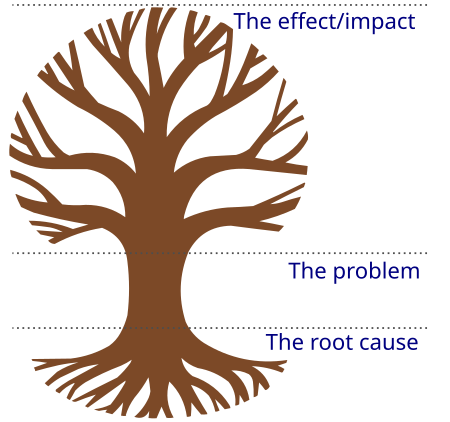Changemakers' Toolkit/Analysing the problem and planning for change/Analysing the problem
Introducing the tool[edit]
A good starting point for any campaign is to gain a better understanding of the issue you are working on. Big or small, local or national, the issue at the centre of your campaign needs to be understood fully so that you can plan your campaign strategy and give yourself the best chance of success.
To get started, it’s important to ask some questions about the issue you are working on so that you form a clear understanding of its causes and effects.
The Problem Tree is a practical tool that helps you delve deeper into the issues you want to tackle.

The trunk of the tree represents the core problem a campaign is trying to address.
The roots of the tree represent the underlying causes of the problem. These could relate to government policies, public attitudes, corporate behaviour, environmental factors or social problems. Try and dig as deep as you can into these root causes.
The branches represent the impacts that the problem is having in the world. These could include health issues, economic problems, inequality, environmental damage, or any form of human suffering. These impacts will often be the main drivers of campaign action.
The problem tree can help your work in several important ways.
- It ensures that you've thought about all the potential causes of your problem, not only the first one that comes to mind.
- It can help to identify 'mini-issues' that form part of the main problem.
- It provides material for your communications and messaging.
- It can help you generate ideas for different angles to tackle the issue from.
- It helps you identify if more information or resources are needed to tackle the problem.
Working through the exercise with your team creates shared understanding and purpose.
Case study[edit]
If we fill in the problem tree, using the example of access to information, it looks like this:

In this example, both the causes and impacts of the problem are varied. Some of the causes are local or individual, such as time and unsuitability of devices to access information. Others are symptoms of global inequities, such as digital poverty.
Similarly, some of the impacts, like lost education, affect individuals. Whereas others, like the spread of misinformation, affect society as a whole.
The purpose of the tree is to draw out these varied causes and impacts. As well as identifying the obvious causes of a problem, you should try and find the underlying or hidden causes. This activity gives us a clearer picture of the current situation. In turn, that allows us to make more effective decisions about routes to change.
Projects that have worked to challenge lack of access to information include the World Health Organisation’s work to expand information on COVID-19; students using Kiwix to access Wikipedia offline in the Andes; advocacy in the Philippines to protect privacy and veto SIM card registration.
Homework exercise[edit]
For this exercise, you’re going to put the problem tree approach into practice. The problem you're trying to understand is homelessness. Print or draw your own blank copy of the problem tree. Then take 10–15 minutes to fill in possible causes and impacts of homelessness.
Next, reflect on how you could apply the problem tree approach to your own issue or campaign. Ideally, brainstorm ideas with other members of your campaign team.
Want to download this exercise to work offline? Click here.
